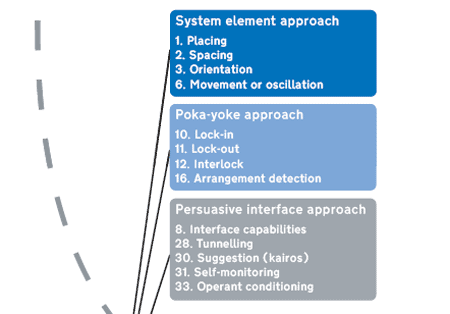
Photo by trancedmoogle.
Back in January, I introduced the Design with Intent method on the blog. I’ve been developing this since then, and, suitably tested and refined, it should form the first stage of the PhD.
Essentially, the DwI Method is intended to be a structured ‘suggestion engine’, where a target behaviour is put in one end, and a range of applicable mechanisms and design techniques, both physical and psychological, come out of the other. The aim is for it to be useful to designers, engineers, architects, policy-makers, and planners of all sorts, who aim to try and shape or change users’ behaviour in some way – and also useful to users in understanding how their behaviour might be manipulated or shaped, for their benefit or someone else’s, by the products, systems and environments around them.
The post in January looked at some of the different design techniques applicable to the target behaviour ‘No access, use or occupation, in a specific manner, by any user’, through the example of anti-homeless benches, and received some really useful feedback from readers (thanks!), as well as forcing me to think more clearly about how the method is structured. Since then the method has evolved considerably, but it’s not yet in the form I want to publish. However, I thought it would be interesting to share an example of applying the method as it currently stands, to a different target behaviour: getting someone to do things in a particular order.
The target behaviour: Introduction

Here I’ve identified a target über-behaviour – We want to shape the way a user follows a process or path – which is inherent to many design problems. There are then (at present) three target sub-behaviours, each of which is subtly different, with different design techniques applicable. In this series of posts I’m going to elaborate on User follows process or path, performing actions in a specified sequence.
Often we (designers/planners/engineers/architects) want the user to do things in a certain order, or follow a path, and are aiming to use the design of the system to help achieve that. The process or path can involve simple spatial sequencing (e.g. making sure shoppers walk past certain items on their way to the checkout), software metaphors for physical procedures (e.g. disabling the ‘Next’ button on a software wizard until required options have been confirmed), or a combination of software logic with physical space (e.g. making sure the user removes his or her bank card from an ATM before the cash is dispensed).
This target behaviour also applies to many safety measures: staggered pedestrian crossings which make sure users turn to face the direction of oncoming traffic, microwave ovens which will not start until the door is closed, cars which will not start unless the clutch is depressed or seat-belt buckled, cars where the ignition key cannot be removed until the automatic transmission is in ‘Park’ mode, machine tools which will not start until a guard is in place, and so on.
Ecodesign applications
Possible ecodesign applications may follow similar lines to the safety measures – particularly, increasing the likelihood that operations are performed in the ‘most efficient’ sequence. A kettle that requires users to pre-select the amount of water required before boiling it, for example, such as the Product Creation Eco-Kettle, aims to have users consider how much boiling water they actually need at the ‘right’ point in the sequence – before boiling. A car’s air conditioning system could require the windows to be fully closed before operating. A bathroom sink could require the plug to be in place before the tap could be left in a ‘running’ position.
Interfaces which suggest the ‘most efficient’ action to the user, at the right point (e.g. a rev-counter-linked light on a car dashboard indicating that it’s time to change gear, as formerly used on a number of Volvo models), can also help encourage users to follow the intended sequence of actions.
Applicable mechanisms/techniques
The DwI method suggests a variety of design techniques applicable to this target behaviour, which fall roughly into three ‘approaches’:

I’ll deal with each of these approaches, with examples of the mechanisms/techniques in action, in the next few posts in this series. Part 2 is up now.
Pingback: Designing the Human » CLASS CALENDAR
Pingback: human after all. » Blog Archive » Exposure and intent
Pingback: Design with Intent « E Waste